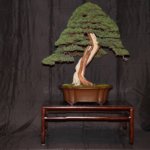As Adair said, I do see the live vein exiting the soil and moving left, setting the directionality to the left, which is likely the difference between my view and yours. Technically, the center of the apex is above that same spot where the live vein leaves the soil, and the foliage mass, to my eye, is evenly split between the two sides, if not heavier on the left.
View attachment 204501
Along with your western/eastern aesthetic, a buddy and I always used to talk about how people “read” trees. Western people print and read top left to bottom right, and that’s the tendency; your eye wants to start at the top left and move right and down. In Japan, they read top right to bottom left, I have no idea if that translates to making trees that more frequently move left. Talking with both Bill and Kathy, they joke that they rarely have enough trees to put on the right end of the display tables because very few of our trees in the West “read” (or move) toward the left.
However, in True Kathy fashion, last year she put this Shimpaku on the left side of the entrance table, and put the ume on the right side. It doesn’t look bad there because it’s up higher than the ume, but to me it looks like it’s trying to exit the scene stage right.
View attachment 204500







